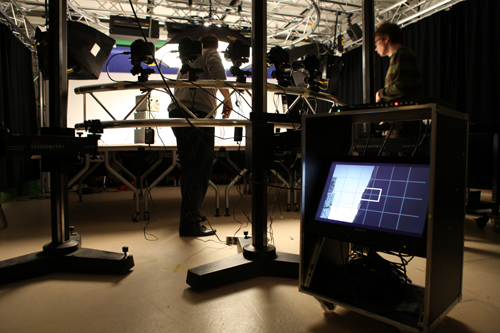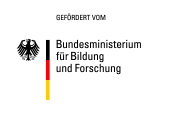For the Technology Enhanced Textbook (TET) and the related production processes we are developing demonstrators that show
whether and how exactly our developments can be didactically and economically viable. The partners with whom we develop
these demonstrators can be found under the menu item "
validation".

Fig.: Television direction in the TET laboratory
Here you can find a brief overview of our planned demonstrators:
Data acquisition via internal and external sensors
Through hardware-specific adaptations of TET, students have the ability to use the internal sensors of mobile devices for
measurements and data analysis. Motion sensors, microphones and cameras can be used for a variety of scientific experiments.
In addition, one can use external sensors for measurements and data analysis via the bluetooth interface of mobile devices.
Augmentation of image data both live and pre-produced
When viewed in augmented reality mode, the environment can be enhanced by multimedia. For example, Interactive Screen
Experiments (ISE) can put real-life phenomena in a virtual surrounding. Objects or phenomena can be identified via geo-tagging,
QR tags, or image recognition processes. We will produce similar enhancements for photo-realistic, virtually accessible
panoramas of laboratories, exhibitions and other environments.
Processes for the production of TET-media based on authentic images
To enable efficient high volume production of authentic- image-based TET media, we develop production assistants that generate
standard ISEs (Interactive Screen Experiments), interactive panoramas, modifiable panoramas, 360 degree ISEs, and S3D-ISEs
(stereo 3D photography). Furthermore, we plan to develop demonstrators for universal data acquisition and for scaling the
generated media.

Fig.: Automated ISE production, multi-camera setup
Communication network and cooperation of the TET-user
For learners at different geographical locations, TET provides the opportunity to work together, synchronously and
asynchronously on real and virtual experiments. The process of conducting a given experiment can be recorded and replayed
as needed to highlight existing problems and challenges of the respective experiment. Interfaces to widespread social
networks like Twitter, Facebook or Google+ allow broad access to sharing activities.
Database access and networking
A universal media platform (IMPAL) serves as backbone for TET's various media applications by storing media elements for a
variety of user scenarios while facilitating multiple use of specific productions. To make this practicable, media element
objects are being tagged with keywords. Further differentiated selection methods are offered depending on specific
requirements of the individual user. In this context we also consider the distribution of editorial content modules prepared
by third party content providers.
TET usability
TET should have an intuitive user interface and provide and integrate different internal and external tools for active
acquisition of knowledge. In particular a flexible portfolio function should allow learners to construct an individual
structure of their knowledge. Using the portfolio feature, teachers can create virtual learning environments that combine
media modules from different suppliers into a single unit. Other tools for annotation, logging, analysis and presentation
are provided as part of the TET user interface.

Fig.: Demonstrator of a multi-touch table, optimized for usage in museums: configuration of the back projection unit
Expanded ways of interaction and representation
For museums or other showrooms, virtual experiment stations will be developed that allow visitors to actively interact with
experiments that are usually not accessible. Many features can be used for this purpose: multi-touch table, spatial gesture
control, stereo imaging technology and mobile devices. The interaction and representation forms of TET will be extended in
the sense that users can create their own experiments based on existing virtual modules and finally share them with others.
The control of experiments via sensors and geo-location data is also planned.
Technology Enhanced Textbook (TET)






